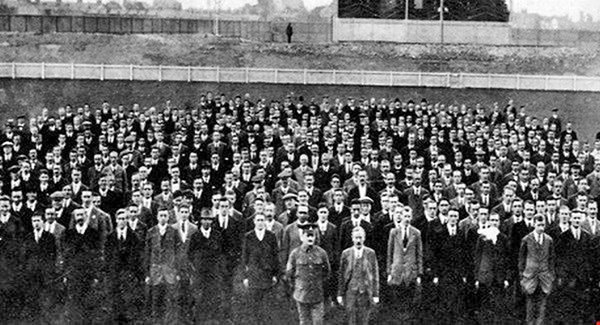
At the time of the 1916 Rising many Irishmen had already volunteered to fight a different war. The Great War in Europe began on July 28th, 1914, and lasted until November 11th, 1918.
It is estimated that some 350,000 Irishmen served in the British forces during World War One. In all, over 30,000 Irish died. Despite being adversaries at home, Irish unionists and nationalists found themselves fighting side-by-side on the battlefields of Europe.
Some Irishmen joined the British forces to fight a ‘just war’, as they saw it. Others, such as constitutional nationalists, were committed to the war by their leader John Redmond, on the basis that Ireland had won Home Rule and were duty-bound to defend similar countries, like Belgium, from the threat of fascism.
When the Irish Rebels led by James Connolly and Patrick Pearse rose against British rule in Ireland, proclaiming an Irish Republic and seizing the GPO and various other strategic buildings in Dublin, it was to Irish units of the British Army based in Ireland that the authorities first turned to defend the Capital. Many of the volunteers who had signed up to fight against Germany subsequently found themselves fighting their fellow Irishmen, in some cases friends and family members.
It is estimated that Irish members of the British forces outnumbered the rebels three to one at the height of the fighting. As many as 41 of the British military deaths during Easter week were Irish-born men, with many more injured.
One of the first to be shot was Frank Browning from Rathmines, Dublin. A barrister-at-law, Browning was 47 years old, a rugby player and former Irish international cricketer who had been capped for Ireland 38 times. He was president of the IRFU and is acknowledged as the driving force behind that organisation’s wartime efforts.
When war broke out in Europe, up to 300 members of the IRFU, like members of sporting clubs across the British Empire, enlisted en bloc. The IRFU volunteers went on to form the Irish Rugby Football Volunteer Corps – D Company, attached to the 7th Royal Dublin Fusiliers. They were also known as the IRFU Pals Battalion.
Of the 300 members of the Lansdowne club, 130 joined up to fight along with 120 ex-members. In total, 72 died in the war, the majority in the Battle of Suvla Bay, Gallipoli and in the Dardanelles.
Browning and a number of his comrades, who remained in Dublin, were caught up in the Battle of Mount Street Bridge. They were fired on by the Irish Rebels as they were returning to Dublin from manoeuvres in Wicklow. Browning was fatally injured and died from his injuries a couple of days later.
A plaque commemorating his death and the deaths of the other members of the IRFU Pals Battalion who lost their lives in WW1 is located just outside the new Aviva Stadium media centre in Lansdowne Road.
By Jennifer Reddin



